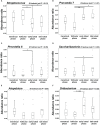Oral microbiome changes associated with the menstrual cycle in healthy young adult females
- PMID: 37065196
- PMCID: PMC10102642
- DOI: 10.3389/fcimb.2023.1119602
Oral microbiome changes associated with the menstrual cycle in healthy young adult females
Abstract
The relationship between the menstrual cycle and the oral microbiome has not been clarified. The purpose of this study was to assess potential changes in the oral microbiome of healthy young adults using 16S rRNA-based sequencing. Eleven females (aged 23-36 years) with stable menstrual cycles and without any oral problems were recruited. Saliva samples were collected before brushing every morning during the menstrual period. Based on basal body temperatures, menstrual cycles were divided into four phases, namely the menstrual, follicular, early luteal, and late luteal phases. Our results showed that the follicular phase had a significantly higher abundance ratio of the Streptococcus genus than the early and late luteal phases, whereas the abundance ratios of the Prevotella 7 and Prevotella 6 genera were significantly lower in the follicular phase than those in the early and late luteal phases and that in the early luteal phase, respectively. Alpha diversity by the Simpson index was significantly lower in the follicular phase than that in the early luteal phase, and beta diversity showed significant differences among the four phases. Using the relative abundance data and copy numbers of the 16S rRNA genes in the samples, the bacterial amounts in the four phases were compared, and we observed that the follicular phase had significantly lower amounts of the Prevotella 7 and Prevotella 6 genera than the menstrual and early luteal phase, respectively. These results indicate reciprocal changes with the Streptococcus genus and Prevotella genera, particularly in the follicular phase. In the present study, we showed that the oral microbiome profiles are affected by the menstrual cycles of healthy young adult females.
Keywords: Prevotella; Streptococcus; menstrual cycle; oral microbiome; saliva.
Copyright © 2023 Yamazaki, Ogura, Minami, Ogai, Horiguchi, Okamoto and Mukai.
Conflict of interest statement
The authors declare that the research was conducted in the absence of any commercial or financial relationships that could be construed as a potential conflict of interest.
Figures





Similar articles
-
Effects of the menstrual and oral contraceptive cycle phases on microvascular reperfusion.Exp Physiol. 2020 Jan;105(1):184-191. doi: 10.1113/EP088135. Epub 2019 Nov 19. Exp Physiol. 2020. PMID: 31625647
-
The healthy female microbiome across body sites: effect of hormonal contraceptives and the menstrual cycle.Hum Reprod. 2022 Jun 30;37(7):1525-1543. doi: 10.1093/humrep/deac094. Hum Reprod. 2022. PMID: 35553675 Free PMC article.
-
Choroidal thickness changes during the menstrual cycle.Curr Eye Res. 2013 Nov;38(11):1172-81. doi: 10.3109/02713683.2013.811258. Epub 2013 Jul 10. Curr Eye Res. 2013. PMID: 23841496
-
Higher Circulating Cortisol in the Follicular vs. Luteal Phase of the Menstrual Cycle: A Meta-Analysis.Front Endocrinol (Lausanne). 2020 Jun 2;11:311. doi: 10.3389/fendo.2020.00311. eCollection 2020. Front Endocrinol (Lausanne). 2020. PMID: 32582024 Free PMC article.
-
The Impact of Menstrual Cycle Phase on Athletes' Performance: A Narrative Review.Int J Environ Res Public Health. 2021 Feb 9;18(4):1667. doi: 10.3390/ijerph18041667. Int J Environ Res Public Health. 2021. PMID: 33572406 Free PMC article. Review.
Cited by
-
Insights into estrogen impact in oral health & microbiome in COVID-19.BMC Microbiol. 2024 Jan 20;24(1):32. doi: 10.1186/s12866-023-03149-5. BMC Microbiol. 2024. PMID: 38245675 Free PMC article.
References
-
- Baser U., Cekici A., Tanrikulu-Kucuk S., Kantarci A., Ademoglu E., Yalcin F. (2009). Gingival inflammation and interleukin-1 beta and tumor necrosis factor-alpha levels in gingival crevicular fluid during the menstrual cycle. J. Periodontol. 80, 1983–1990. doi: 10.1902/JOP.2009.090076 - DOI - PubMed
-
- Bostanci N., Krog M. C., Hugerth L. W., Bashir Z., Fransson E., Boulund F., et al. . (2021). Dysbiosis of the human oral microbiome during the menstrual cycle and vulnerability to the external exposures of smoking and dietary sugar. Front. Cell. Infect. Microbiol. 11. doi: 10.3389/FCIMB.2021.625229 - DOI - PMC - PubMed
Publication types
MeSH terms
Substances
LinkOut - more resources
Full Text Sources

